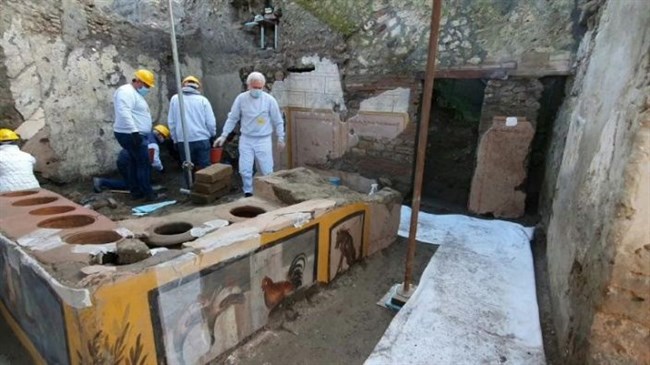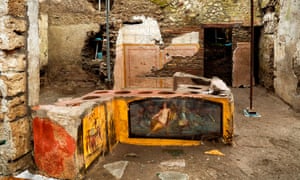Researchers said on Saturday they had discovered a frescoed thermopolium or fast-food counter in an exceptional state of preservation in Pompeii.
The ornate snack bar, decorated with polychrome patterns and frozen by volcanic ash, was partially exhumed last year but archaeologists extended work on the site to reveal it in its full glory.
Pompeii was buried in ash and pumice when the nearby Mount Vesuvius erupted in AD79, killing between 2,000 and 15,000 people. Archaeologists continue to make discoveries there.
The thermopolium of Regio V at what was a busy intersection of Silver Wedding Street and Alley of Balconies was the Roman-era equivalent of a fast-food snack stall.
A fresco bearing an image of a Nereid nymph riding a seahorse and gladiators in combat had been unearthed previously.
In the latest stage of their work, archaeologists uncovered a number of still life scenes, including depictions of animals believed to have been on the menu, notably mallard ducks and a rooster, for serving with wine or hot beverages.
Scientists were also able to glean precious new information on gastronomic habits in the town dating from the eruption, which engulfed Pompeii and the neighbouring town of Herculaneum.
The team found duck bone fragments as well as the remains of pigs, goats, fish and snails in earthenware pots. Some of the ingredients had been cooked together rather than prepared separately as a Roman-era paella.
Crushed fava beans, used to modify the taste of wine, were found at the bottom of one jar.
“As well as bearing witness to daily life in Pompeii, the possibilities to analyse afforded by this thermopolium are exceptional because for the first time we have excavated a site in its entirety,” said Massimo Osanna, director general at the Archaeological Park of Pompeii.
Amphorae, a water tower and a fountain were also found alongside human remains, including those of a man believed to have been about 50 and discovered near a child’s bed.
“The counter seems to have been closed in a hurry and abandoned by its owners but it is possible that someone, perhaps the oldest man, stayed behind and perished during the first phase of the eruption,” Osanna told Ansa news agency.
The remains of another person may be those either of an opportunist thief or someone fleeing the eruption who was “surprised by the burning vapours just as he had his hand on the lid of the pot that he had just opened”, added Osanna.
The thermopolium – the word comes from the Greek “thermos” for hot and “poleo” to sell – was very popular in the Roman world. Pompeii alone had around 80.
Pompeii is Italy’s second most visited site after the Colosseum in Rome and last year attracted about 1 million tourists.




